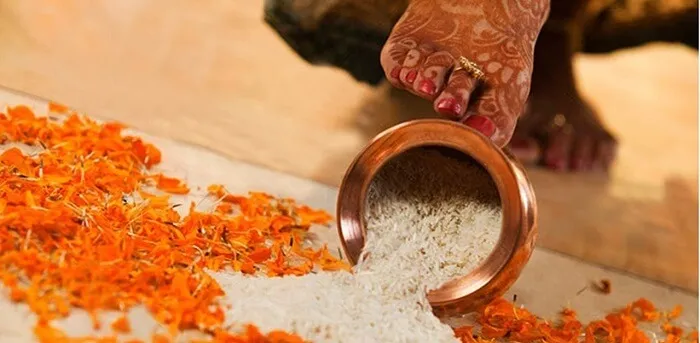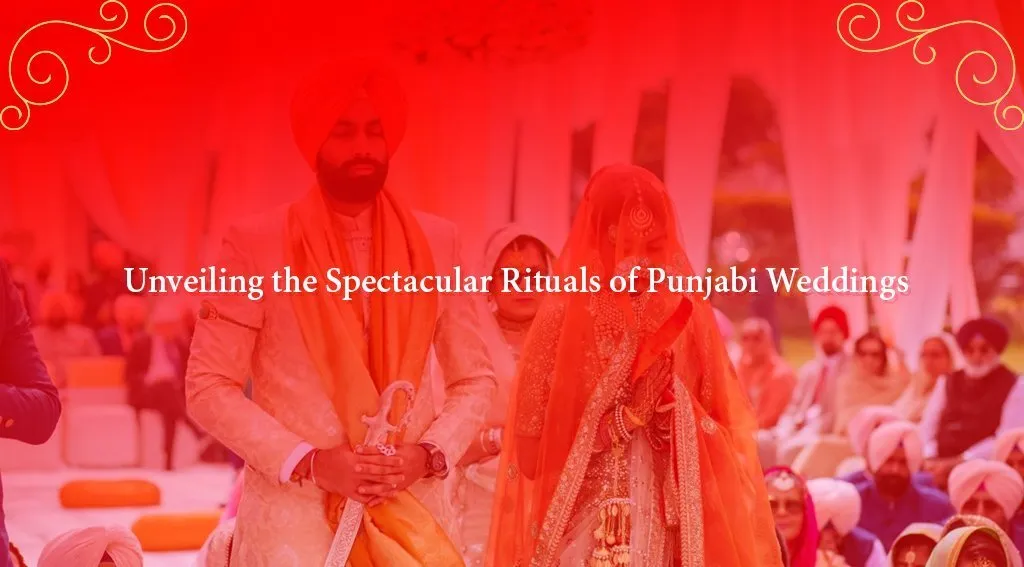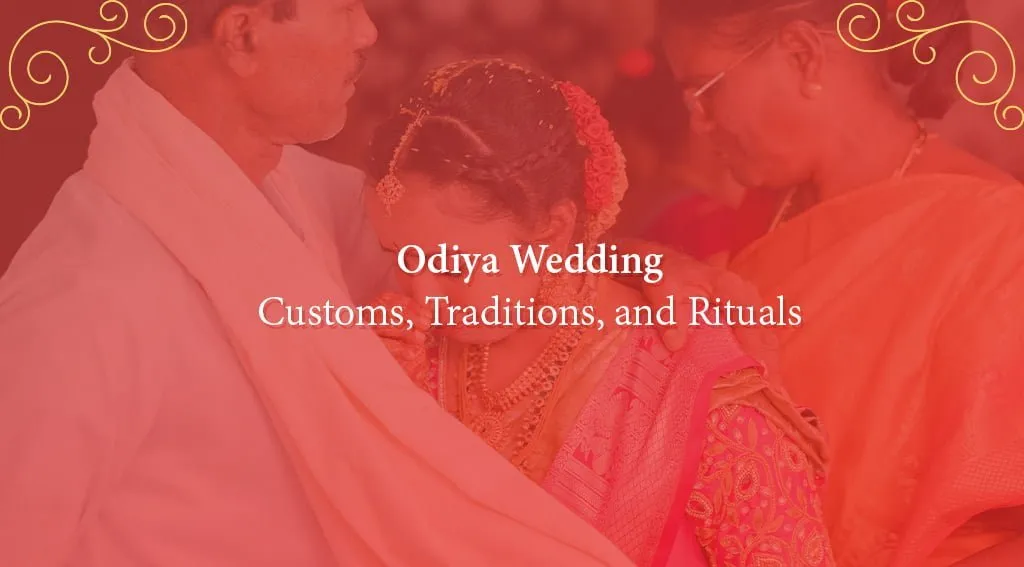A Gujarati wedding is a vibrant and joyous celebration of two families coming together in union. With its intricate and meaningful rituals, customs, and traditions, it is an occasion that is steeped in culture and heritage. In this comprehensive guide, we will explore the different rituals and customs that make up a Gujarati wedding and their significance.
List of Gujarati Wedding Rituals, Customs, and Traditions
The Gujarati wedding is a beautiful Gujju way of celebrating love and unity between two families. It consists of various ceremonies and rituals that mark the beginning of a new journey for the bride and groom.
Pre-Wedding Rituals
Chandlo Maatli

The first ceremony is the Chandlo Maatli, where the father of the bride and four male relatives. They visit the groom’s place with a steel container or maatli full of sweets and gifts for the groom and his family. He then applies chandlo or a red circle at the center of the groom’s forehead and fixes the marriage date.
Gol Dhana
The Gol Dhana ceremony is a pre-wedding ritual where the engagement between the bride and groom is formalized. The bride’s family brings gifts and sweets for the groom and his family. The couple exchanges ring, symbolizing their commitment to each other. The term “Gol Dhana” means “round grains,” and it is named after the coriander seeds and jaggery that are distributed to the guests as a symbol of the sweetness and spice of life.
Ganesh Maatli/ Ganesha Sthapan

The Ganesha Sthapan or Ganesha Maatli is the beginning of wedding ceremonies and rituals. In this ceremony, both families conduct Ganesh Pooja at their homes a few days before the wedding, praying for a happy and successful married life.
Mehendi Ceremony

Like in every Indian wedding, Gujaratis also host a Mehendi function for the bride. Mostly this ceremony takes place two days before the wedding. The hands and feet of the bride are decorated with henna amidst the singing of folk songs and a bit of dance as well.
Mandap Mahurat
The Mandap Mahurat is an auspicious ceremony where the parents of the couple seek blessings of Mother Earth and also take permission from her to start the digging of a piece of land to erect a mandap.
Pithi

The Pithi ceremony is similar to the haldi ceremony, in which a paste of sandalwood, turmeric, saffron, rosewater, and perfume is applied to the groom by friends and family at their respective homes. The turmeric included in the paste is considered auspicious and also a beauty enhancer.
Griha Shanti
The Griha Shanti ceremony is held immediately after the Mandap Mahurat. In this ceremony, the blessings of all the nine planets of the solar system are sought by both the bride’s and groom’s families. Griha Shanti is a mandatory ceremony in a Gujarati wedding.
Sanji/Sangeet Sandhya

The Sanji/Sangeet Sandhya is a lively ceremony at a Gujarati wedding, where family members and friends gather to perform the traditional Garba dance. This is a fun-filled event where everyone dances to the beat of the dhol and the rhythm of the songs.
Also Read | Know About Telugu Marriage Rituals, Tradition and Customs
Mameru
The Mameru ceremony, also known as Mosaalu, is held one or two days before the wedding, the maternal uncle of the bride visits her and brings gifts, including sweets, sarees, jewelry, and other clothes. This ceremony symbolizes the love and affection of the uncle towards his niece and his blessings for her future married life.
The Wedding Day Rituals
Varghodo

The Varghodo ritual is an exuberant event that celebrates the groom’s journey to the wedding venue and symbolizes the beginning of the marriage festivities. It is an occasion filled with joy, music, dance, and vibrant cultural traditions that bring both families together in anticipation of the wedding ceremony.
Jaimala

As the bride and groom meet at the Mandap, they exchange beautifully adorned garlands, signifying their acceptance of each other as life partners.
Kanya Aagman
The bride makes a grand entrance, accompanied by her maternal uncles. The groom’s mother performs an Aarti to welcome the bride into the family.
Madhuparka

The Madhuparka ritual holds deep cultural significance. Traditionally, the groom sits on a low wooden stool called “patla” during the Madhuparka ceremony. This sitting posture is considered respectful and appropriate for the occasion. The bride’s family prepares a special concoction made of milk, honey, yogurt, and ghee. This mixture symbolizes a sweet and cordial welcome for the groom.
Antarpaat
Antarpaat refers to a special cloth or curtain that is used to separate the bride and groom during the wedding ceremony until the appropriate moment. The Antarpaat serves as a symbolic barrier that separates the bride and groom until the auspicious moment when they are revealed to each other during the wedding ceremony.
Kanyadaanam

The next ritual is the ‘Kanyadaanam’, where the father of the bride gives her hand in marriage to the groom. This is a symbolic gesture of the father’s trust and confidence in the groom to take care of his daughter.
Hasta Milap

The couple’s hands are tied together with a sacred thread by the priest, signifying their eternal commitment to each other.
Saptapadi
The couple takes seven vows, each step signifying a promise to fulfill their responsibilities as life partners.
Sindoor Dan and Mangalsutra

The groom applies sindoor (vermilion) on the bride’s hair parting, symbolizing her marital status.In this significant ritual, the groom ties the Mangalsutra around the bride’s neck, symbolizing their eternal bond.
Post-Wedding Rituals
Ashirvad

The newlywed couple seeks blessings from their elders for a prosperous and happy married life.
Vidai:
Vidaai is an emotional moment where the bride says goodbye to her family and leaves for her new home. The bride’s father gives her hand to the groom, symbolizing that he is now responsible for his daughter’s well-being.
Griha Pravesh

Upon arriving at the groom’s home, the bride is welcomed with traditional aarti and is showered with rice and coins for good luck.
Ghar Nu Laxmi
The Ghar Nu Laxmi is a ceremony where the bride is welcomed into the groom’s home as the Goddess Laxmi, who shall bring good fortune into the house. The mother-in-law places a vessel filled with rice at the entrance, and then the bride is asked to spill the vessel by touching it with her right foot. This ritual symbolizes wealth and the bride’s acceptance of her responsibilities toward her new home.
Aeki Beki

The Aeki Beki game is played after the Ghar Nu Laxmi ceremony. In this game, a tray of water mixed with milk and sindoor (vermilion) is placed with several coins along with a ring. Then the couple is asked to find the ring, and whoever finds the ring four out of seven times shall rule the household. The day concludes with prayers offered to God for blessing the newlywed couple.
Reception

A grand reception is held to introduce the newlyweds to their extended family and friends. It is a time for celebrations, dance, and feasting.
Conclusion
Gujarati weddings are a beautiful and colorful celebration of culture, heritage, and love. With their intricate rituals and customs, they showcase the rich history and traditions of the Gujarati community. From the joyous pre-wedding celebrations to the emotional post-wedding rituals, every moment of a Gujarati wedding is filled with meaning and significance.
Matrimilan is a matchmaking service that specializes in helping Gujarati brides and grooms find their ideal match. We understand the cultural values and traditions that are important in Gujarati weddings and strive to connect couples.
Matrimilan loves the Gujarati community and is dedicated to helping them find love and happiness through our services. For more information, connect through our website and find your ideal Gujarati match.
FAQ
What is the significance of the Sindoor Daan and Mangalsutra ceremonies in a Gujarati wedding?
In the Sindoor Daan ceremony, the groom applies sindoor (vermilion powder) to the bride’s forehead, symbolizing her status as a married woman. The groom then ties a mangal sutra (sacred necklace) around the bride’s neck, symbolizing their eternal bond.
What are the seven vows taken by the bride and groom in the Hasta Melap ceremony?
The seven vows taken by the bride and groom in the Hasta Melap ceremony are known as Saptapadi. They represent the promises they make to each other, including love, trust, respect, and commitment.
What is the Kanyadaan ceremony at a Gujarati wedding?
Kanyadaan is the moment when the father of the bride gives away his daughter’s hand in marriage to the groom. The father washes the groom’s feet and presents him with gifts, symbolizing his acceptance of him as his daughter’s husband.





